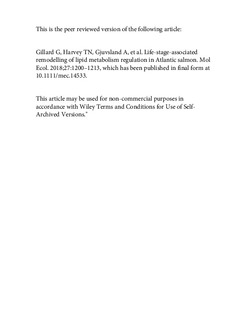Life-stage associated remodeling of lipid metabolism regulation in Atlantic salmon
Gillard, Gareth Benjamin; Harvey, Thomas Nelson; Gjuvsland, Arne Bjørke; Jin, Yang; Thomassen, Magny Sissel S.; Lien, Sigbjørn; Leaver, Michael; Torgersen, Jacob Seilø; Hvidsten, Torgeir Rhoden; Vik, Jon Olav; Sandve, Simen Rød
Journal article, Peer reviewed
Accepted version
Permanent lenke
http://hdl.handle.net/11250/2564964Utgivelsesdato
2018Metadata
Vis full innførselSamlinger
Sammendrag
Atlantic salmon migrates from rivers to sea to feed, grow and develop gonads before returning to spawn in freshwater. The transition to marine habitats is associated with dramatic changes in the environment, including water salinity, exposure to pathogens and shift in dietary lipid availability. Many changes in physiology and metabolism occur across this life‐stage transition, but little is known about the molecular nature of these changes. Here, we use a long‐term feeding experiment to study transcriptional regulation of lipid metabolism in Atlantic salmon gut and liver in both fresh‐ and saltwater. We find that lipid metabolism becomes significantly less plastic to differences in dietary lipid composition when salmon transitions to saltwater and experiences increased dietary lipid availability. Expression of genes in liver relating to lipogenesis and lipid transport decreases overall and becomes less responsive to diet, while genes for lipid uptake in gut become more highly expressed. Finally, analyses of evolutionary consequences of the salmonid‐specific whole‐genome duplication on lipid metabolism reveal several pathways with significantly different (p < .05) duplicate retention or duplicate regulatory conservation. We also find a limited number of cases where the whole‐genome duplication has resulted in an increased gene dosage. In conclusion, we find variable and pathway‐specific effects of the salmonid genome duplication on lipid metabolism genes. A clear life‐stage‐associated shift in lipid metabolism regulation is evident, and we hypothesize this to be, at least partly, driven by nondietary factors such as the preparatory remodelling of gene regulation and physiology prior to sea migration.
